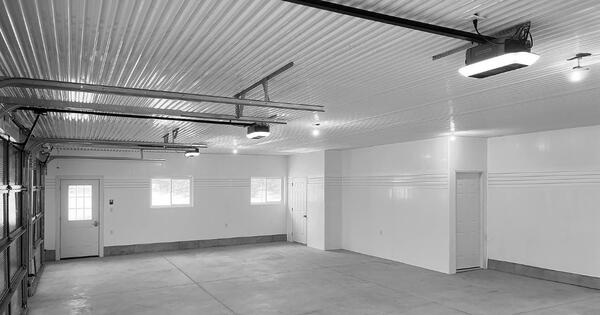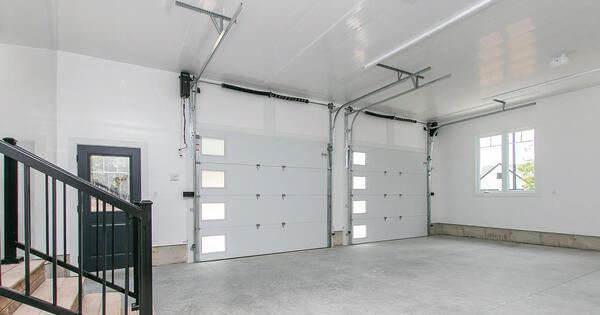When you're building or renovating a garage, following building codes isn't just about checking off boxes — it's about ensuring safety, structural integrity, and compliance with local regulations. Building codes help maintain consistency in construction standards, protecting you, your property, and your neighbors from potential hazards.
It's important to remember that while many requirements apply broadly, they can vary from town to town and state to state or province to province. That's why it's always essential to consult your local building authority before starting any project to confirm the specific codes in your area.
Ignoring or overlooking building codes can lead to serious consequences. If your garage doesn't meet local requirements, you could face fines, be forced to halt construction, or even be required to tear down parts of your project and start over. Additionally, improperly built structures may fail inspection, making it difficult to sell or insure your home in the future. More importantly, not following the codes can pose safety risks — putting your property and the people around it in danger.
Garage Zoning Laws and Building Permits
Before you break ground on your new garage, it’s essential to understand the zoning laws in your area and obtain the necessary permits. Zoning laws regulate where you can build on your property, and failing to follow these guidelines can lead to fines or the removal of your structure. Permits are required to ensure your project is up to code, and they help local authorities confirm that your garage won't violate any zoning or safety regulations.
Do I need a permit to build a garage?
In most cases, yes — you'll need a building permit to construct a garage, whether it's attached or detached. This permit ensures that your plans comply with local building codes and safety standards. Some smaller, prefabricated garages or sheds might not require a permit, but it’s always a good idea to check with your local building department.
Are there restrictions on where I can place my garage on my property?
Yes, zoning laws often restrict where a garage can be located on your property. For example, there are usually setbacks — minimum distances required between your garage and property lines or other structures. Zoning laws may also limit the size or height of the garage and whether it can be attached to the main house or built as a standalone structure. These restrictions are in place to ensure proper space between buildings and to maintain neighborhood aesthetics.
How do I check the zoning laws in my area?
To check the zoning laws that apply to your property, you can start by visiting your local municipal or county planning office. Many areas also have zoning maps and regulations available online. Additionally, speaking with a local building inspector or planning department can provide you with detailed information about any restrictions or special requirements for your garage project.

Garage Size and Height Building Code Restrictions
The size and height of your garage are governed by local building codes, and these rules are designed to ensure safety, proper use of space, and compliance with zoning regulations. While exact dimensions may vary depending on where you live, there are general guidelines that apply to most areas.
Are there minimum or maximum size requirements for garages?
Most local building codes specify a minimum size for a garage, typically based on whether it’s designed to accommodate one or more vehicles. A standard single-car garage is usually around 12 feet by 20 feet, while a two-car garage might be 20 feet by 20 feet or larger. As for maximum sizes, this depends largely on your property’s zoning. Many areas limit the footprint of garages relative to the overall lot size or require larger garages to be located a certain distance from property lines.
Can I build a two-story garage?
Yes, in many cases you can build a two-story garage, but this depends on your local zoning laws and building codes. Some areas limit the height of accessory structures like garages to ensure they don’t overpower neighboring buildings. If you’re planning a two-story garage, it’s crucial to review height restrictions, which often vary between 12 and 25 feet depending on your location.
How do I find out the height restrictions for my garage?
To determine height restrictions, you’ll need to consult your local building department or zoning office. These rules are typically part of your area’s zoning laws, and they might vary depending on whether the garage is attached or detached, or based on the overall height of other structures on your property. Many municipalities have this information available online, but speaking with a building inspector can provide more detailed insight.
Foundation and Flooring Building Code Requirements
The foundation is the literal base of your garage, and it must meet building code standards to ensure stability, durability, and safety. Whether you’re building a small single-car garage or a large structure for heavy vehicles, the foundation needs to be properly designed to support the load and comply with local regulations. The flooring also needs to be up to code, especially if you're planning to use the garage for heavy equipment or large vehicles.
What kind of foundation does my garage need?
Most building codes require a concrete slab foundation for garages, as it provides a stable and durable base. Depending on your location and the weight your garage will need to support, you may be required to install a thicker slab or use a reinforced foundation. In colder climates, frost-protected foundations are often necessary to prevent cracking or shifting caused by ground movement.
Are there specific concrete thickness requirements for garage flooring?
Yes, garage floors typically need to be at least four inches thick to meet most building codes. If you're using the garage to store heavy vehicles or equipment, you may need a thicker slab — often five to six inches — with reinforcement such as steel mesh or rebar to prevent cracking under the load.
Do I need to reinforce the garage foundation if I’m using it for heavy equipment or vehicles?
Yes, if you plan to store heavy vehicles or machinery in your garage, reinforcing the foundation is essential. Reinforcement might involve using a thicker slab or adding materials like steel rebar or wire mesh to increase the strength of the concrete. Some building codes may specify additional requirements if the load exceeds certain limits, so it’s always a good idea to check with a professional before beginning construction.
Garage Electrical and Plumbing Building Codes
Installing electrical and plumbing systems in your garage isn’t just a matter of convenience — it also needs to be done safely and in compliance with building codes. From wiring and outlets to lighting and plumbing fixtures, there are several regulations you’ll need to follow to ensure your garage is functional and up to code.
What are the electrical requirements for a garage?
Garages typically require dedicated electrical circuits to handle the demands of tools, lighting, and appliances. Building codes will specify how many circuits are necessary, where outlets should be placed, and what type of wiring is required. In most areas, you’ll need to install outlets every six to 12 feet along the walls, as well as ceiling outlets for lighting. Using the correct gauge of wire and properly grounding the electrical system is also critical for safety.
Do I need GFCI outlets in my garage?
Yes, ground-fault circuit interrupter (GFCI) outlets are required in most garages by building codes. GFCIs protect against electrical shocks by cutting power if they detect an imbalance in the electrical current. This is particularly important in garages, where moisture or wet conditions may be present, increasing the risk of shock.
If I add plumbing (e.g., for a sink), what codes should I follow?
If you’re adding plumbing to your garage, such as a sink or a drain, you’ll need to follow local plumbing codes, which will specify the type of piping, venting, and drainage systems you need to install. Plumbing systems must be properly vented to prevent sewer gases from entering your garage, and all connections need to be watertight. You may also need a permit to install plumbing, so it’s a good idea to check with your local building department before starting.
Garage Doors and Egress Building Code Requirements
When it comes to garage doors, ensuring that they meet safety standards is key, not just for daily use but also for emergency situations. Building codes include specific requirements to ensure that garage doors are secure, accessible, and allow for proper egress in case of emergencies. Egress refers to the ability to exit safely, which is particularly important in garages that may be attached to a home or have multiple entry points.
Do garage doors need to meet specific safety standards?
Yes, garage doors must meet safety standards outlined by local building codes. These standards typically address both the structural integrity of the door and safety mechanisms like auto-reverse features. For example, most areas require that automatic garage doors have sensors that detect obstructions and reverse if anything is in the door's path — preventing accidents or injuries. Garage doors should also be wind-rated in regions prone to hurricanes or strong winds to reduce the risk of damage.
What is an egress requirement, and how does it apply to my garage?
Egress refers to a safe exit path that allows you to leave a space in case of an emergency. In garages, egress requirements ensure that you can quickly and safely exit, especially if the garage is attached to your home. If your garage has living spaces above or connected to it, egress regulations may include the need for side doors or windows that provide an escape route. These additional exits ensure that you’re not relying solely on the main garage door, which could malfunction or be blocked in an emergency.
Can I install a window or a side door for emergency exits?
Yes, installing a window or a side door in your garage can meet egress requirements and improve overall safety. Windows used for egress must meet specific size and accessibility standards, ensuring they are large enough for a person to escape through. Side doors provide an additional exit point and are a common feature in garages to enhance accessibility, especially in emergencies.

Fire Safety and Insulation Standards
Fire safety is a top priority in any garage, particularly if it’s attached to your home. Building codes outline specific fire safety measures to prevent fires from spreading between your garage and living spaces. Additionally, insulation requirements are in place to ensure proper thermal performance and fire resistance, especially in attached garages.
Do I need fire-rated walls between my garage and house?
Yes, if your garage is attached to your home, most building codes require fire-rated walls between the garage and any living space. This wall is typically referred to as a "fire separation" and is designed to slow the spread of fire from the garage to the rest of your home. The wall usually needs to be built with materials that have at least a one-hour fire rating, such as 5/8-inch Type X drywall. This can give occupants more time to safely exit the house in case of a fire.
What fire safety measures do I need to consider?
Beyond fire-rated walls, there are other fire safety measures to consider. For example, the door connecting the garage to the home should be fire-rated as well — usually a solid-core door with a minimum 20-minute fire rating. Additionally, sealing any gaps or holes in the walls that connect the garage to living spaces is crucial to prevent the spread of smoke or fire. In some cases, building codes may also require the installation of smoke alarms or heat detectors in attached garages for added protection.
Are there specific insulation requirements for attached garages?
Yes, insulation standards for attached garages are typically governed by energy codes to ensure thermal efficiency. Depending on your climate zone, your garage walls and ceilings may need to meet certain R-value requirements (a measure of insulation effectiveness). For fire safety, it’s also important to use fire-resistant insulation materials, especially in the walls that connect the garage to living areas. Insulation not only helps with energy efficiency but also plays a role in slowing the spread of fire.
Garage Ventilation and Exhaust Building Code Requirements
Proper ventilation in a garage is essential for maintaining air quality and ensuring safety, particularly if your garage is attached to your home or used to house gas-powered vehicles or tools. Without adequate ventilation, fumes from vehicles and tools can accumulate, leading to potentially dangerous conditions. Building codes often outline the need for ventilation to prevent these hazards.
Do I need to add ventilation to my garage?
Yes, most building codes require garages to have proper ventilation, especially if the garage is attached to your home. This helps prevent the buildup of harmful fumes, such as carbon monoxide from cars or exhaust from gas-powered equipment. Inadequate ventilation can pose serious health risks, so it’s critical to ensure there’s enough airflow to disperse any pollutants.
How should I handle exhaust ventilation for gas-powered tools or vehicles?
For garages housing gas-powered tools or vehicles, it’s essential to have a dedicated exhaust ventilation system. This could include installing vents or exhaust fans that direct fumes outside. In some cases, local codes may specify the minimum air changes per hour required to safely remove exhaust gases. For garages attached to homes, it’s important to keep any exhaust vents far from windows or doors to prevent fumes from entering living spaces.
What are the ventilation requirements for a heated garage?
If you plan to heat your garage, ventilation becomes even more important to maintain safe air quality and prevent moisture buildup. Heated garages often need additional vents or exhaust fans to ensure the space remains well-ventilated. For gas-powered heating systems, you’ll need to install proper ventilation to handle any emissions. Building codes may also specify how much ventilation is needed based on the size of the garage and the type of heating system you’re using.
Building Codes for Attached vs. Detached Garages
It’s important to know that building codes differ depending on whether the garage is attached to your home or stands on its own. These differences exist because attached garages are connected to living spaces, which raises additional safety and structural concerns. Understanding these distinctions will help you ensure your garage meets all necessary requirements and keeps your home safe.
Are there different building codes for attached versus detached garages?
Yes, the building codes for attached and detached garages differ. Attached garages are subject to stricter fire safety requirements because they share walls with your home’s living areas. These garages must have fire-rated walls, doors, and, in some cases, ceilings to prevent fires from spreading to the main structure. Detached garages, on the other hand, don’t need to meet the same fire safety requirements, though they still need to follow other construction and safety codes.
Does a detached garage require a fire-rated wall?
Generally, detached garages don’t require a fire-rated wall unless they’re located very close to your home or another structure. Building codes often specify that a detached garage must be a certain distance away from any other buildings to avoid fire risks. If the garage is built too close, local codes might require a fire-rated wall to provide extra protection. Always check your local building codes for specific distance and wall requirements.
Are the setback requirements different for attached and detached garages?
Yes, setback requirements typically vary between attached and detached garages. A setback refers to the distance your garage must be from your property lines. For attached garages, setbacks are usually based on the same rules that apply to the main house. Detached garages, however, often have different setback rules — usually requiring more distance from property lines or other structures. Check your zoning laws for specific setback regulations in your area.



Trusscore Wall&CeilingBoard and Garage Building Code Requirements
When planning a garage construction project, it's crucial to ensure that all materials used meet local building codes, especially for elements like fire safety and thermal performance. Trusscore Wall&CeilingBoard offers durability and versatility, but it’s important to know where it fits into specific code requirements.
Does Trusscore Wall&CeilingBoard meet the requirements for a fire-rated wall assembly?
Trusscore Wall&CeilingBoard doesn’t meet the requirements for fire resistance if a fire-rated wall assembly is specified by code. To meet code requirements, Trusscore Wall&CeilingBoard must be installed on top of an approved a fire-rated wall or ceiling assembly. Here are a couple of examples of fire-rated wall assemblies commonly used in building construction and their components:
- Fire-Rated Garage Separation Wall: Fire-rated assembly using 5/8-inch Type X gypsum board designed to separate a residential garage from a living space.
- One-Hour Fire-Rated Wall Assembly: 5/8-inch Type X gypsum board on both sides of 2x4 wood studs with insulation. Joints and penetrations are sealed with fire-rated caulk.
These examples are generic and may need to be adapted based on specific building codes, local regulations, and the intended use of the building. It's important to consult with local code authorities and follow approved designs and specifications to ensure compliance with fire safety standards.

Can Trusscore Wall&CeilingBoard be used as a thermal barrier for spray foam insulation?
Trusscore Wall&CeilingBoard can’t be used as a substitute for thermal barriers. In construction using spray foam insulation, a thermal barrier like gypsum board, thermal coatings or intumescent paints, and other approved materials must be in place before you install Trusscore products — this ensures compliance with safety regulations and enhances the fire resistance of the structure.
It’s especially important to install a thermal barrier in accordance with building codes before installing Trusscore products in living spaces and other occupied areas of a building.
Do I need to install a vapor barrier with Trusscore Wall&CeilingBoard?
Trusscore Wall&CeilingBoard isn’t a vapor barrier, and you'll need to install a one in addition to your Trusscore panels if your project requires one. Refer to your local building code to determine if your project requires a vapor barrier.
Garage Energy Efficiency and Sustainability Standards
As energy efficiency becomes a higher priority in construction, garages are also subject to energy codes, particularly in colder climates where maintaining heat can be a concern. Following these codes can make your garage more energy-efficient, lowering your heating or cooling costs and reducing your environmental impact.
Do I need to meet energy efficiency standards when building a garage?
In most cases, attached garages are required to meet basic energy efficiency standards, especially if they share walls with conditioned living spaces. Detached garages, on the other hand, may not always need to meet these standards unless they’re heated or cooled. However, many areas encourage energy-efficient construction even for garages, particularly in regions with extreme weather conditions.
What insulation and energy requirements apply to garage construction?
For attached garages, building codes often require that walls shared with living spaces meet specific insulation standards to improve energy efficiency and prevent heat transfer. The most common insulation requirement is based on the R-value, which measures thermal resistance. In colder climates, you’ll need higher R-values for your garage walls and ceilings. If your garage is detached but heated, it will likely need to meet similar insulation standards to ensure it’s energy-efficient.
How can I build an energy-efficient garage that meets local codes?
To build an energy-efficient garage, start by using high-quality insulation in the walls, ceiling, and doors. You should also install energy-efficient windows and doors to minimize drafts. In colder climates, consider sealing all joints and openings to prevent heat loss. Finally, use energy-efficient lighting and, if applicable, heating systems that meet local energy codes. If you’re unsure about the specific requirements, your local building authority or contractor can guide you on the codes in your area.
Garage Inspection Requirements
Ensuring your garage meets building codes doesn’t stop at construction. Inspections are a critical part of the process, as they confirm that every aspect of your garage — from the foundation to the electrical wiring — complies with local regulations. Knowing when and what to expect during these inspections will help you avoid any delays or costly issues.
When will my garage need to be inspected during the construction process?
Your garage will typically need to be inspected at various stages of construction to ensure code compliance. Common inspection points include the foundation, framing, electrical, and plumbing systems, as well as the final inspection once construction is complete. Each inspection checks whether the work at that stage meets local building codes before you can move forward with the next phase of construction.
What should I expect during a building inspection for my garage?
During an inspection, a building official will come to the site and review the work completed so far, comparing it against the local building code standards. They’ll inspect elements like the structure, materials, safety features, and compliance with zoning laws. Inspections are usually scheduled ahead of time, and the inspector will either approve the work, allowing you to continue, or request changes to bring it up to code.
Who should I contact to ensure my garage meets all building codes?
You should start by contacting your local building department or zoning office. They can provide you with the specific building codes and zoning laws that apply to your area. Additionally, working with a licensed contractor, architect, or structural engineer can ensure your plans and construction meet all the necessary standards. These professionals are experienced in navigating building codes and can guide you through the process.
Can a contractor handle the permit and inspection process for me?
Yes, a qualified contractor can handle most of the permit and inspection process on your behalf. Contractors are usually well-versed in local building codes and can take care of applying for permits, scheduling inspections, and ensuring that your garage meets all necessary requirements. By hiring a professional, you can focus on the bigger picture while they manage the technical details.
What happens if my garage fails an inspection?
If your garage fails an inspection, you’ll need to correct the issues cited by the inspector before you can proceed. The inspector will typically provide a list of required fixes, which could range from minor adjustments to significant changes. Once the issues are resolved, you’ll need to schedule a follow-up inspection. Failing to address these problems could result in delays, additional costs, or even fines if you move forward without proper approval.
Following building codes is essential for ensuring your garage is safe, durable, and compliant with local laws. Whether you’re building from scratch or renovating, adhering to these standards helps you avoid costly fines, legal issues, and safety hazards. While this guide provides a general overview of common code requirements, local codes vary, so it’s always a good idea to consult with professionals to make sure your project is on the right track.






